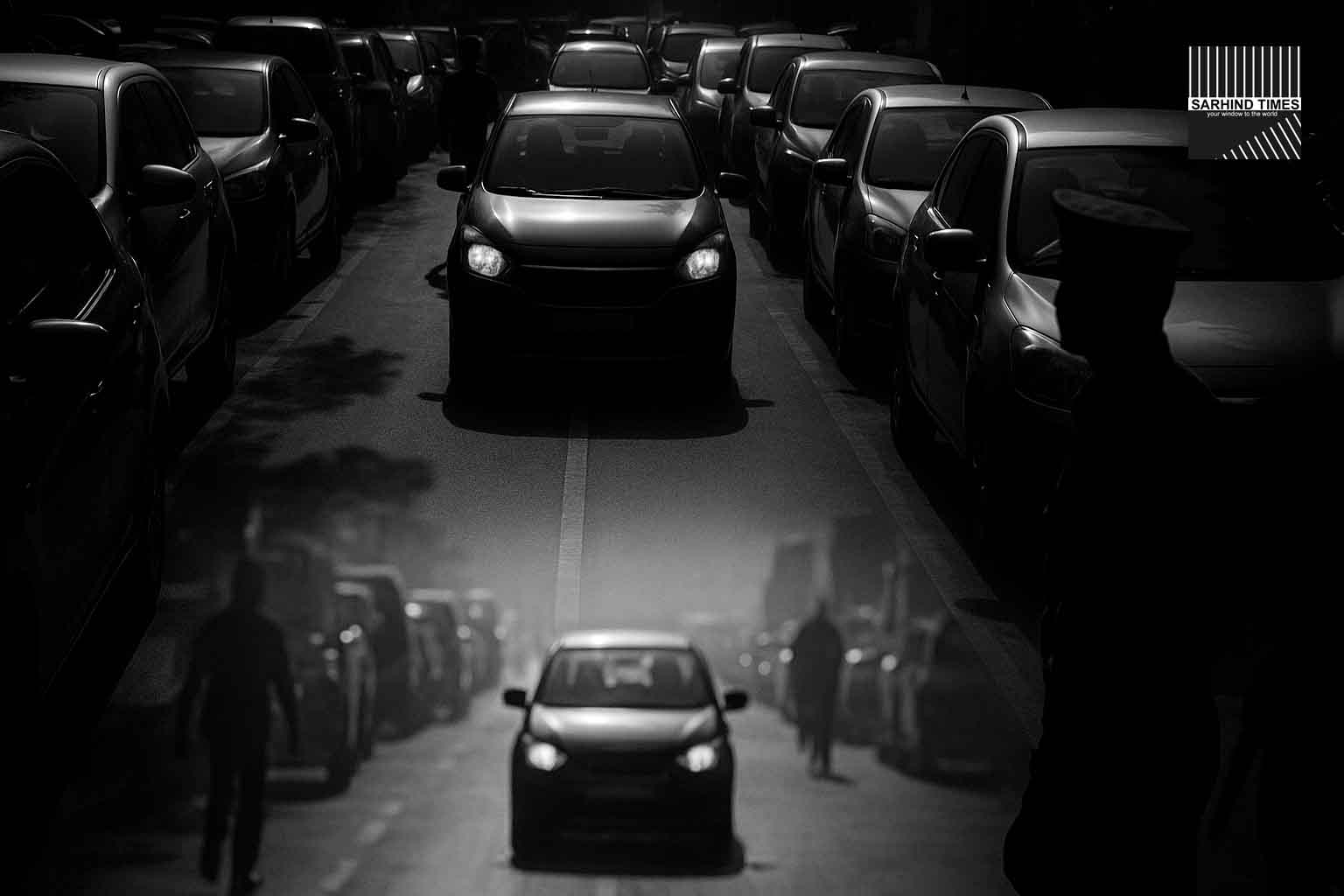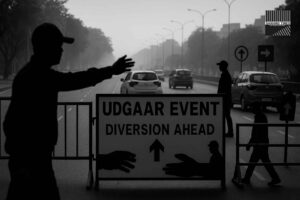Gurugram, October 12, 2025 — The festive fervour in Gurugram is bringing more than lights and shopping — it’s bringing snarls, especially on Vikas Marg near Arcadia Market, Sector-49, as illegal parking tightens carriageways and tests the city’s traffic resilience. In a spot check at around 5:20 pm, vehicles were found double-parked on both sides, choking the road and causing tailbacks of nearly 200 metres. Commuters reported waiting multiple signal cycles to cross even small stretches. Local RWAs and shopkeepers have demanded stronger enforcement, tow trucks and marshals during peak hours. Traffic police acknowledge the challenge, promising periodic drives, but say resources are strained across multiple markets this season.
Urban planners warn this is a chronic symptom of deeper design and policy deficits: insufficient parking supply, weak last-mile infrastructure, mixed-use clusters lacking parking integration, and lax enforcement. As Gurugram gears up for Diwali, the clash of pedestrian bustle and vehicle growth is exposing the limits of its urban mobility fabric.
Below is a full exploration: incident narrative, systemic drivers, enforcement responses, planning prescriptions, and what citizens and authorities alike must do.
Incident & Immediate Context
What Happened on Vikas Marg / Arcadia Market
During the late afternoon spot check, teams found:
- Vehicles double-parked on both flanks of the road, reducing effective carriage width by nearly half.
- A queue of cars stretching ~200 m near Arcadia Market, Sector 49, delaying even small through-traffic.
- Commuters noted that even minor maneuvers — a U-turn or crossing movement — triggered gridlock in the confined space.
- Many shoppers admitted they had no option but to park illegally as legal parking slots were full months earlier in the day.
- Similar pressure was seen at markets in Sadar Bazaar, Sector 14, Galleria, and other commerce hubs, where both sides of narrow streets were lined with parked vehicles.
According to Hindustan Times, the Municipal Corporation and traffic police had designated certain parking spots (e.g. near Civil Hospital, Rajiv Chowk, etc.), but these filled up early.
Official Response & Enforcement Drives
- The Assistant Commissioners of Police and zonal officers were summoned in a high-level meeting by DCP (Traffic) Dr. Rajesh Mohan to coordinate enforcement, ensuring illegal‐parking norms are enforced stringently.
- On-the-ground towing and seizing of vehicles violating no-parking zones were ordered.
- The Municipal Corporation of Gurugram (MCG) acknowledged that a 7-floor multi-level parking structure built near Old Railway Road (capacity for “thousands” of vehicles) has remained non-functional thus far due to operational approval delays.
- That parking facility is expected to be made operational “in the next two months,” per an official.
- A surface parking lot in Kaman Sarai is under construction to alleviate demand near Galleria / market clusters.
- The City issued notices that roads with low traffic volumes may be officially converted to parking lanes to improve utilization.
From January to September 2025, over 1,28,988 challans have already been issued in Gurugram for illegal parking.
Root Causes & Structural Challenges
The Vikas Marg bottleneck is symptomatic of deeper systemic issues in Gurugram’s urban mobility and parking planning.
1. Parking Supply Deficit & Underutilised Infrastructure
- The demand for parking, especially in high-footfall commercial clusters, far exceeds legally provided capacity. Many society basements, commercial complexes, and markets fail to provide enough slots.
- The multi-level parking near Arcadia remains dormant despite physical completion, due to operational/approval inertia.
- Some roads which could accommodate side-lane parking have not been officially gazetted for parking use, leaving them as de facto illegal zones used by overflow traffic.
2. Mixed-Use, Last-Mile & Design Flaws
- Shopping markets, residential pockets, and narrow internal roads are interwoven, but parking and circulation haven’t been planned cohesively.
- Many last-mile transit corridors remain weak, forcing private vehicles to dominate even short distances. A study showed that last-mile connectivity is one of the biggest hurdles in Gurugram, pushing dependence on private vehicles.
- Transit planning and parking policies are siloed, so parking design is not aligned with mobility nodes, public transport access, or pedestrian flows.
3. Enforcement & Institutional Weakness
- Traffic police and municipal enforcement resources get stretched thin during festive or high-traffic seasons, reducing consistency of anti-parking drives.
- Encroachments by shops onto sidewalks and road margins shrink usable road width and parking margins. In the Arcadia area, shopfront extensions squeeze residual road space.
- Lack of follow-up in anti-encroachment drives undermines earlier actions — the DTCP’s earlier campaign had faded.
4. Behavior & Demand Management Failures
- Many motorists choose convenience over legality, expecting weak enforcement or toleration.
- Drivers cruising for parking or double-parking to avoid walking a few more steps is a classic demand overflow problem.
- There’s limited use of dynamic pricing, incentives, or parking reservation systems to discourage prolonged occupation or encourage turnover.
5. Fragmented Governance & Coordination Gaps
- Multiple agencies (MCG, MCGS, DTCP, GMDA, traffic police) need to align on parking zoning, regulation, operations, and enforcement.
- Operational handoff, approvals, and maintenance responsibilities often fall through the cracks.
- Infrastructure built (like the dormant multi-level parking) remains unused due to operational or legal logjams.
Comparative Insights & Policy References
Integrated Mobility Planning for Gurgaon / Manesar
The Integrated Mobility Plan (Gurgaon-Manesar Urban Complex) outlines parking management strategies:
- Designation of parking zones, demand-based pricing, shared parking arrangements, structured parking, and leveraging peripheral satellite lots.
- Emphasis on balancing parking supply with transit access and non-motorised transport to reduce congestion.
Parking Incentivization Frameworks
Recent research suggests feedback control frameworks for incentivising suburban parking utilization and traffic relief in urban cores. These systems dynamically push drivers toward underutilized parking zones using incentives or pricing.
Applying such models in Gurugram could help balance demand during peak seasons and reduce double-parking pressure near busy markets.
Precedent of Parking Drives
- In September 2024, Gurugram traffic police and Road Safety Organisation (RSO) launched a campaign educating residents about no-parking zones, issuing challans, distributing pamphlets, and mobilizing social media awareness.
- Such awareness + enforcement drives have seen moderate success in curbing violations temporarily — but are rarely sustained long-term without structural reforms.
What Should Be Done: Prescriptions for Relief & Reform
Short-Term (Festive Season / Immediate Response)
- Peak-Hour Marshals & Towing Deployment
- Deploy traffic marshals and tow trucks specifically during high traffic windows (e.g. 4 pm–8 pm) near Arcadia, Sector 49 and adjacent markets.
- Coordinate with RWAs / market associations to manage ingress and egress flows.
- Temporary Drop-Off Zones & Peripheral Lots
- Designate and signpost drop-off / short-stop zones near markets to discourage full parking in main carriageway.
- Open nearby vacant plots or surface lots as temporary parking for festival traffic.
- Strict Enforcement & Quick Sanctification
- Enforce no-parking zones strictly, issue fines and tow in repeated violation spots.
- Use CCTV / e-challan to identify habitual offenders.
- Close encroachments and reclaim road margins immediately.
- Public Communication & Parking Advisories
- Release frequent alerts (via radio, local apps, social media) advising peak times, alternate parking spots, walking distance maps.
- Encourage use of public transport, pooled rides, or off-peak shopping.
Mid-Term (1–2 Years)
- Operationalize Dormant Parking Infrastructure
- Make the multi-level parking near Old Railway Road functional via fast-track approvals and operations.
- Activate Kaman Sarai surface lot and other planned lots.
- Integrate payment, access, security systems.
- Zoned Parking & Differential Pricing
- Introduce demand-responsive pricing: higher rates in high-demand zones, lower rates in peripheral ones.
- Limit parking tenure during peak hours to turnover capacity.
- Lease or partner with nearby societies / complexes for shared parking.
- Smart Parking Technology & Reservation Systems
- Deploy apps / platform integration that shows available parking slots in real-time, allows reservation.
- Use sensors / IoT in parking lots to track occupancy and guide drivers.
- Redesign Streetscapes & Parking Allocation in Planning
- In new developments, ensure adequate off-street parking, internal circulation, and buffer zones.
- Retrofit certain low-traffic lanes as formal parking lanes as per use.
- Introduce pedestrian-first corridors, widened sidewalks, and reduce conflict between foot traffic & parked vehicles.
- Link with Public Transit / Last-Mile Integration
- Encourage people to park further in transit hubs and ride last mile to markets via shuttles, e-rickshaws, or foot.
- Improve last-mile connectivity, which studies show strongly influences private vehicle use for short trips.
- Use feeder services and shared mobility to reduce reliance on direct private vehicle trips into market zones.
Long-Term (3–5 Years & Institutional Change)
- Parking Zoning & Regulation Reform
- Codify parking zones, allowable on-street/off-street parking in municipal / master plans.
- Require parking impact analysis and compliance for future commercial / mixed-use projects.
- Integrated Urban Mobility Governance
- Create a unified mobility authority (combining traffic, parking, planning) for holistic policy and enforcement.
- Tie parking policy to transport demand, environment policy, land use regulation.
- Institutional Maintenance, Audits & Accountability
- Regular performance audits of parking facilities, enforcement efficacy, and compliance.
- Feedback loops: complaints, sensor data, field monitoring to detect leakage or failure.
- Transparency dashboards showing occupancy, violations, enforcement data to public.
- Behavioral Incentives & Public Culture Shift
- Incentivize use of off-site or shared parking (e.g. discounts, valet systems).
- Public education on “park responsibly” campaigns, community norms, peer pressure.
- Penalty escalation for repeat offenders or commercial establishments facilitating illegal parking.
Potential Risks & Challenges
- Resistance from shopkeepers / businesses who fear loss of customer footfall if parking is pushed farther.
- Legal or operational delay in activating dormant parking lots due to approvals or vendor selection.
- Enforcement fatigue: policing requires sustained resources, and short-term drives may lose momentum.
- Technology adoption lag: real-time parking sensors, reservation apps require investment and adaptation.
- Behavioral inertia: drivers accustomed to convenience may resist walking or shared mobility shift.
- Coordination complexity: multiple agencies (MCG, traffic, planning, DTCP, parking authorities) must align — any friction undermines progress.
Case Scenario: What If No Action Happens
If the status quo continues unchecked:
- Congestion on Vikas Marg will escalate — longer delays, fuel wastage, emission increase, pedestrian risk.
- Public frustration will mount, leading to unplanned behavior (parking everywhere) — spillover into adjacent lanes.
- The market environment may degrade if access becomes too onerous for shoppers.
- Roads may see conflicts, vehicle damage, blocking of emergency vehicles.
- Without structural change, each Diwali will repeat the cycle, eroding urban liveability.
Conclusion
The illegal parking crisis on Vikas Marg during Gurugram’s festive rush is a visible symptom of mobility stress, parking shortage, design misalignments, and enforcement gaps. Addressing it requires both immediate tactical action (towing, marshals, communication) and deeper strategic reforms (parking infrastructure, pricing, smart systems, transit integration, governance reforms).
If authorities and citizens seize this Diwali as a pivot point — activating unused infrastructure, enforcing rules consistently, and planning for a more balanced urban mobility regime — the city may gradually tip from reactive congestion to managed, resilient flow. But delay only tightens the squeeze.
#Gurugram #Traffic #Parking #FestiveSeason #UrbanPlanning






















+ There are no comments
Add yours